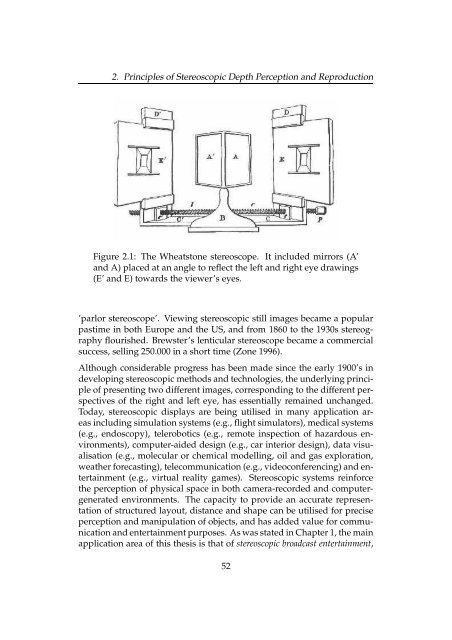Chapter 2 Principles of Stereoscopic Depth Perception and ...
Chapter 2 Principles of Stereoscopic Depth Perception and ...
Chapter 2 Principles of Stereoscopic Depth Perception and ...
Create successful ePaper yourself
Turn your PDF publications into a flip-book with our unique Google optimized e-Paper software.
2. <strong>Principles</strong> <strong>of</strong> <strong>Stereoscopic</strong> <strong>Depth</strong> <strong>Perception</strong> <strong>and</strong> Reproduction<br />
Figure 2.1: The Wheatstone stereoscope. It included mirrors (A’<br />
<strong>and</strong> A) placed at an angle to reflect the left <strong>and</strong> right eye drawings<br />
(E’ <strong>and</strong> E) towards the viewer’s eyes.<br />
’parlor stereoscope’. Viewing stereoscopic still images became a popular<br />
pastime in both Europe <strong>and</strong> the US, <strong>and</strong> from 1860 to the 1930s stereography<br />
flourished. Brewster’s lenticular stereoscope became a commercial<br />
success, selling 250.000 in a short time (Zone 1996).<br />
Although considerable progress has been made since the early 1900’s in<br />
developing stereoscopic methods <strong>and</strong> technologies, the underlying principle<br />
<strong>of</strong> presenting two different images, corresponding to the different perspectives<br />
<strong>of</strong> the right <strong>and</strong> left eye, has essentially remained unchanged.<br />
Today, stereoscopic displays are being utilised in many application areas<br />
including simulation systems (e.g., flight simulators), medical systems<br />
(e.g., endoscopy), telerobotics (e.g., remote inspection <strong>of</strong> hazardous environments),<br />
computer-aided design (e.g., car interior design), data visualisation<br />
(e.g., molecular or chemical modelling, oil <strong>and</strong> gas exploration,<br />
weather forecasting), telecommunication (e.g., videoconferencing) <strong>and</strong> entertainment<br />
(e.g., virtual reality games). <strong>Stereoscopic</strong> systems reinforce<br />
the perception <strong>of</strong> physical space in both camera-recorded <strong>and</strong> computergenerated<br />
environments. The capacity to provide an accurate representation<br />
<strong>of</strong> structured layout, distance <strong>and</strong> shape can be utilised for precise<br />
perception <strong>and</strong> manipulation <strong>of</strong> objects, <strong>and</strong> has added value for communication<br />
<strong>and</strong> entertainment purposes. As was stated in <strong>Chapter</strong> 1, the main<br />
application area <strong>of</strong> this thesis is that <strong>of</strong> stereoscopic broadcast entertainment,<br />
52


